Saturday Morning Fever: CBS 1968
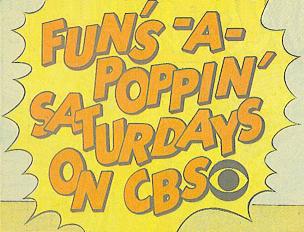 The concept of a Saturday morning network television line up began in 1962 when all three networks began to schedule programs for children on the weekends. Initially these were reruns of movies and television shows aimed at the younger audience but original programming began to filter in slowly. By 1968, Saturday mornings were filled with shows for children and some of the more recent offerings were now relegated to the tail end of the schedule. This meant that pre-teen patrons of pop culture could fill up on six whole hours of cartoon creations before staggering out into the sunshine!
The concept of a Saturday morning network television line up began in 1962 when all three networks began to schedule programs for children on the weekends. Initially these were reruns of movies and television shows aimed at the younger audience but original programming began to filter in slowly. By 1968, Saturday mornings were filled with shows for children and some of the more recent offerings were now relegated to the tail end of the schedule. This meant that pre-teen patrons of pop culture could fill up on six whole hours of cartoon creations before staggering out into the sunshine!
CBS made a bold move in 1968 by backing their schedule up one hour to begin at 8AM. Traditionally, the 8-9AM spot had been left open for local programming which usually consisted of the wrap up of the all night movies, news, or syndicated screenings of older offerings like the Three Stooges or Little Rascals. CBS not only went after the early risers, undoubtedly hoping they wouldn’t change the channel for the rest of the morning, but they staked their claim with two brand new shows. Of course the designation of “new” can be a very liberal term where children’s programming is concerned and often only applies to the packaging not the contents. (ABC and NBC joined CBS the following year and Saturday morning television’s start time was officially moved to 8AM where it stayed for the remainder of its existence).
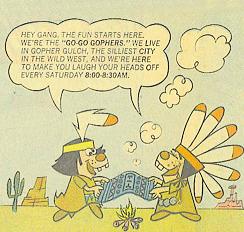 Leading off the line up was a “new” offering from Total Television, the producers of the popular Underdog cartoon show, The Go Go Gophers. The Gophers had made their debut two years earlier as part of the Underdog show, which returned to NBC this year. This was, however, the first time these insane Indians had headlined their own series.
Leading off the line up was a “new” offering from Total Television, the producers of the popular Underdog cartoon show, The Go Go Gophers. The Gophers had made their debut two years earlier as part of the Underdog show, which returned to NBC this year. This was, however, the first time these insane Indians had headlined their own series.
Westerns were popular on television in the 60’s and the Gophers provided a humorous parody of the classic struggle between the Native American Indians and the United States Cavalry. Each week, Chief Running Board and Ruffled Feathers, the last of the Gopher Indian tribe, would defend their little plot of land, Gopher Gulch, from Colonel Kit Coyote and Sergeant Oakey Homa. The latter two characters were, you guessed it, coyotes!
A typical Go Go Gophers cartoon would have the Colonel and Sergeant carrying out some bizarre plan devised by their superiors to finally get ride of the Gophers once and for all. This was complicated by the Gopher’s having their own, even more bizarre, plan to counter the Cavalry. The mute Ruffled Feathers was usually the one to concoct these schemes and he communicated them to Running Board through a spastic form of sign language. Running Board’s typical reply to the preposterous plots was “Whoopee Doopee, we have fun”! By the end of the five minute cartoons, the Cavalry was always thwarted and the Gophers lived to fight another day.
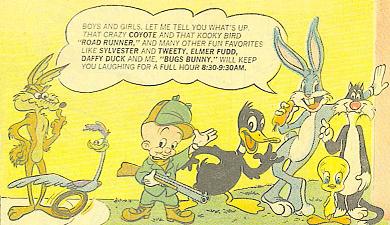 Neither Bugs Bunny nor the Road Runner were strangers to television by 1968 but CBS combined the two together into a format that would serve as a cornerstone for Saturday mornings, bounced back and forth between CBS and ABC, for over three decades! The Bugs Bunny / Road Runner Hour was actually a repackaging of a repackaging. The Bugs Bunny Show had debuted in prime time on ABC in 1960 as a combination of Warner Brothers’ theatrical cartoons joined together by new segments of animation. The show was handed down to the ABC Saturday morning schedule two years later. In 1968, CBS purchased the rights to the program and combined it with its already popular Road Runner Show which had been airing for the past two seasons. This allowed CBS to expand the show to an hour long format and utilize the newer bridging segments done for prime time. Bugs Bunny, Daffy Duck, Wile E. Coyote, the Road Runner, Tweety, Sylvester, and all their friends proved to be the most resilient and consistently enjoyable cartoons ever broadcast on television and they remained in the Saturday morning line up until 2000, when the entire Warner Brothers catalog was sold to Cartoon Network.
Neither Bugs Bunny nor the Road Runner were strangers to television by 1968 but CBS combined the two together into a format that would serve as a cornerstone for Saturday mornings, bounced back and forth between CBS and ABC, for over three decades! The Bugs Bunny / Road Runner Hour was actually a repackaging of a repackaging. The Bugs Bunny Show had debuted in prime time on ABC in 1960 as a combination of Warner Brothers’ theatrical cartoons joined together by new segments of animation. The show was handed down to the ABC Saturday morning schedule two years later. In 1968, CBS purchased the rights to the program and combined it with its already popular Road Runner Show which had been airing for the past two seasons. This allowed CBS to expand the show to an hour long format and utilize the newer bridging segments done for prime time. Bugs Bunny, Daffy Duck, Wile E. Coyote, the Road Runner, Tweety, Sylvester, and all their friends proved to be the most resilient and consistently enjoyable cartoons ever broadcast on television and they remained in the Saturday morning line up until 2000, when the entire Warner Brothers catalog was sold to Cartoon Network.
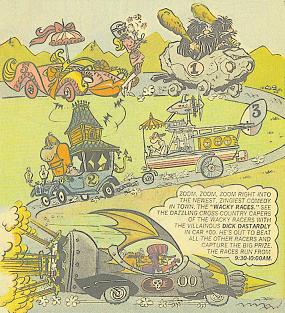 At 9:30, the first truly new CBS cartoon of the season made its debut. The Wacky Races was an animated take on the tried and true road race plot with some pretty strange vehicles and even stranger drivers. The main contestants were the hopelessly narcissistic Peter Perfect, the stereotypical serial heroine Penelope Pitstop, and the token villain Dick Dastardly and his wise-ass dog Mutley. They were joined on the road by a crazy inventor, loopy lumberjacks, midget gangsters, a supped up tank, and even a couple of cavemen! Each week the racers would face a new challenge or contest and usually beat each other silly trying to win it. Wacky Races proved so popular that both Penelope Pitstop and Dick Dastardly were each spun off into their own series the following year.
At 9:30, the first truly new CBS cartoon of the season made its debut. The Wacky Races was an animated take on the tried and true road race plot with some pretty strange vehicles and even stranger drivers. The main contestants were the hopelessly narcissistic Peter Perfect, the stereotypical serial heroine Penelope Pitstop, and the token villain Dick Dastardly and his wise-ass dog Mutley. They were joined on the road by a crazy inventor, loopy lumberjacks, midget gangsters, a supped up tank, and even a couple of cavemen! Each week the racers would face a new challenge or contest and usually beat each other silly trying to win it. Wacky Races proved so popular that both Penelope Pitstop and Dick Dastardly were each spun off into their own series the following year.
Next was the highlight of the 1968 season, The Archie Show. Archie Andrews and his friends at Riverdale High School had been entertaining kids for close to thirty years in the comic books so it only made sense to transfer them to the small screen. Filmation provided the animation for the series and, borrowing the concept from the prime time show The Monkees, the gang also became an aspiring musical group with a new song featured each week. The plots of the shows usually centered around typical high school high jinx or evil rich kid Reggie trying to show up Archie and his pal Jughead to impress Betty and Veronica. The show itself was nothing truly special but it did pave the way for Scooby Doo a year later, which at least gave the teen friends a mystery to solve each week and help keep viewers awake. In 1969, one of the songs, Sugar, Sugar, went to number one on the record charts (I always preferred Melody Hill and Waldo P. Emerson Jones myself) and The Archies became Saturday morning staples for almost two decades.
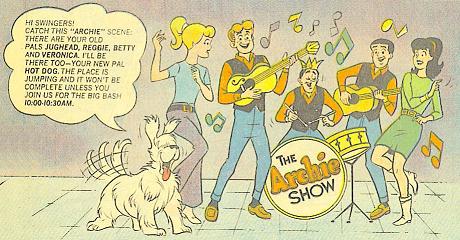 Superman had been a presence on Saturday morning television since The New Adventures of Superman had premiered in 1966. In 1967, the man of steel was teamed with the unlikely partner of Aquaman for The Superman / Aquaman Hour of Adventure. In spite of a variety of supporting cartoons that featured many of DC Comic’s most popular characters of the day, the show was canceled after one season and the King of the seas was banished to Sunday morning repeats and then obscurity.
Superman had been a presence on Saturday morning television since The New Adventures of Superman had premiered in 1966. In 1967, the man of steel was teamed with the unlikely partner of Aquaman for The Superman / Aquaman Hour of Adventure. In spite of a variety of supporting cartoons that featured many of DC Comic’s most popular characters of the day, the show was canceled after one season and the King of the seas was banished to Sunday morning repeats and then obscurity.
Superman was trotted out again in 1968 for a far more enjoyable pairing with his co-star from World’s Finest Comics, Batman. The caped crusader was big business in 1967 thanks to his successful live action prime time series that had premiered the year before on ABC. The new program, creatively titled The Batman Superman Hour of Adventure, also lasted only a single season. The CBS 1969 Saturday morning line-up was surprisingly superhero-less but the incredibly popular Superfriends show was only a few years off.
CBS filled the remaining two and a half hours of its 1968 Saturday programming, 11:30-2PM, with reruns from previous season. The bulk of these were entertaining Hanna-Barbera adventure shows like The Herculoids, Shazzan (a giant pampas genie), and everyone’s favorite boy adventurer, Jonny Quest. Since most of these programs were recent, they made an excellent lead out for the morning. The final offering at 1:30, was the relatively obscure animated adventures of the Lo

